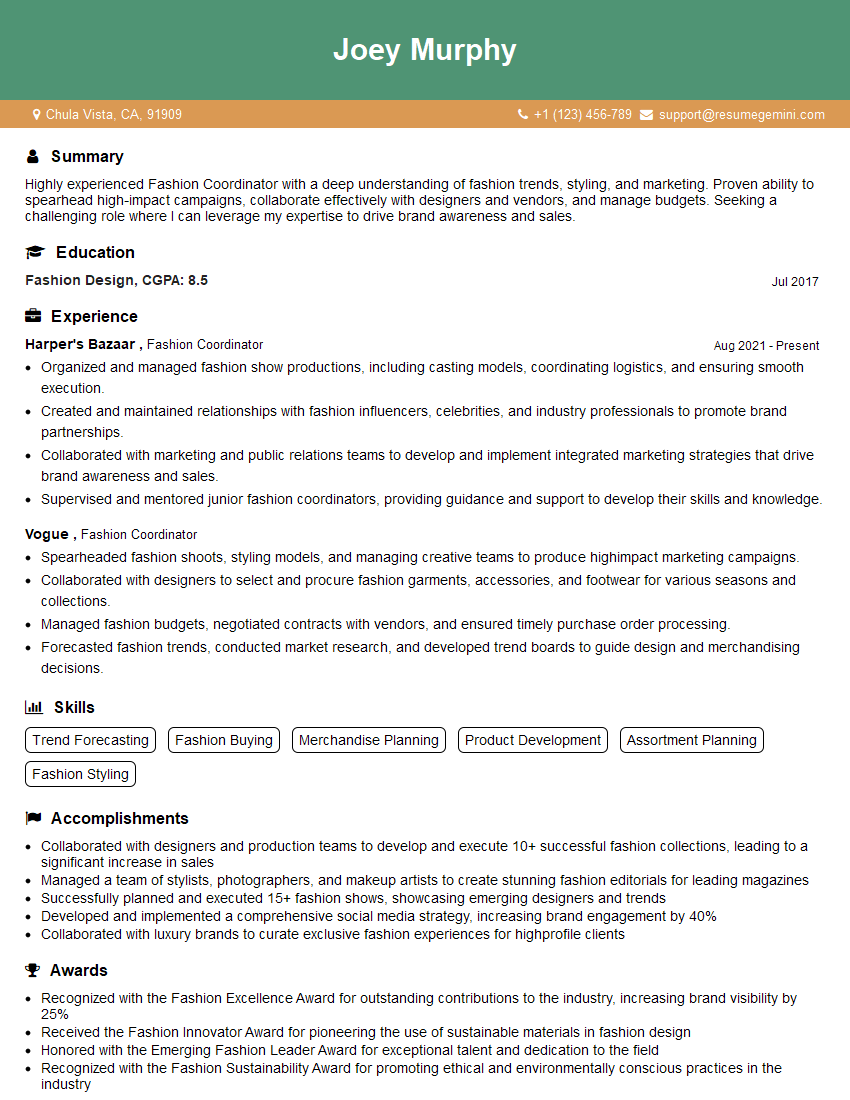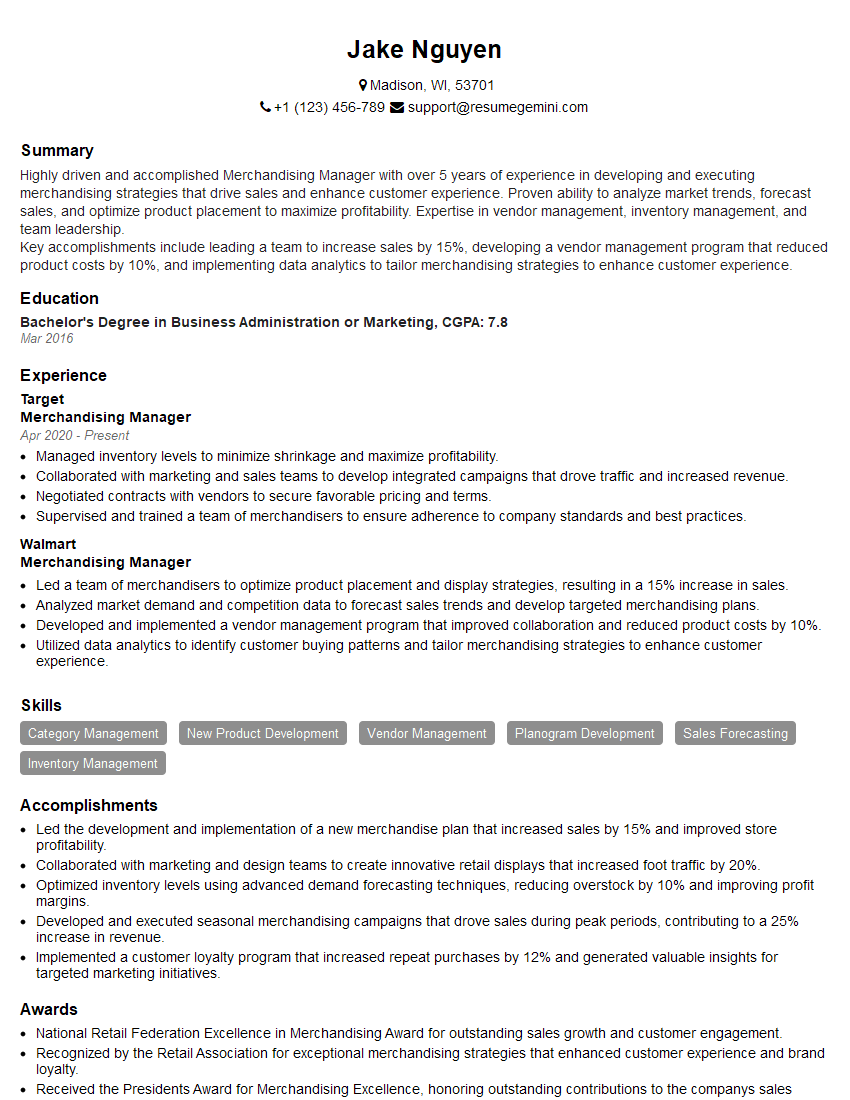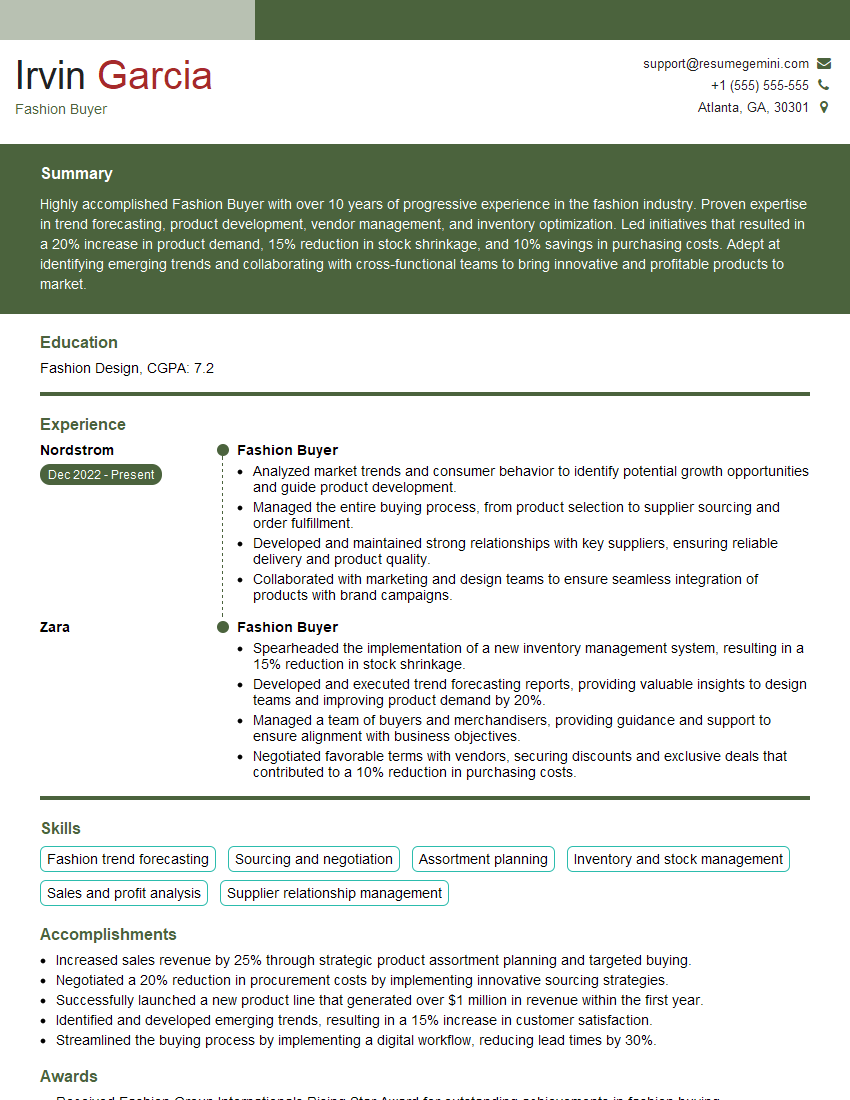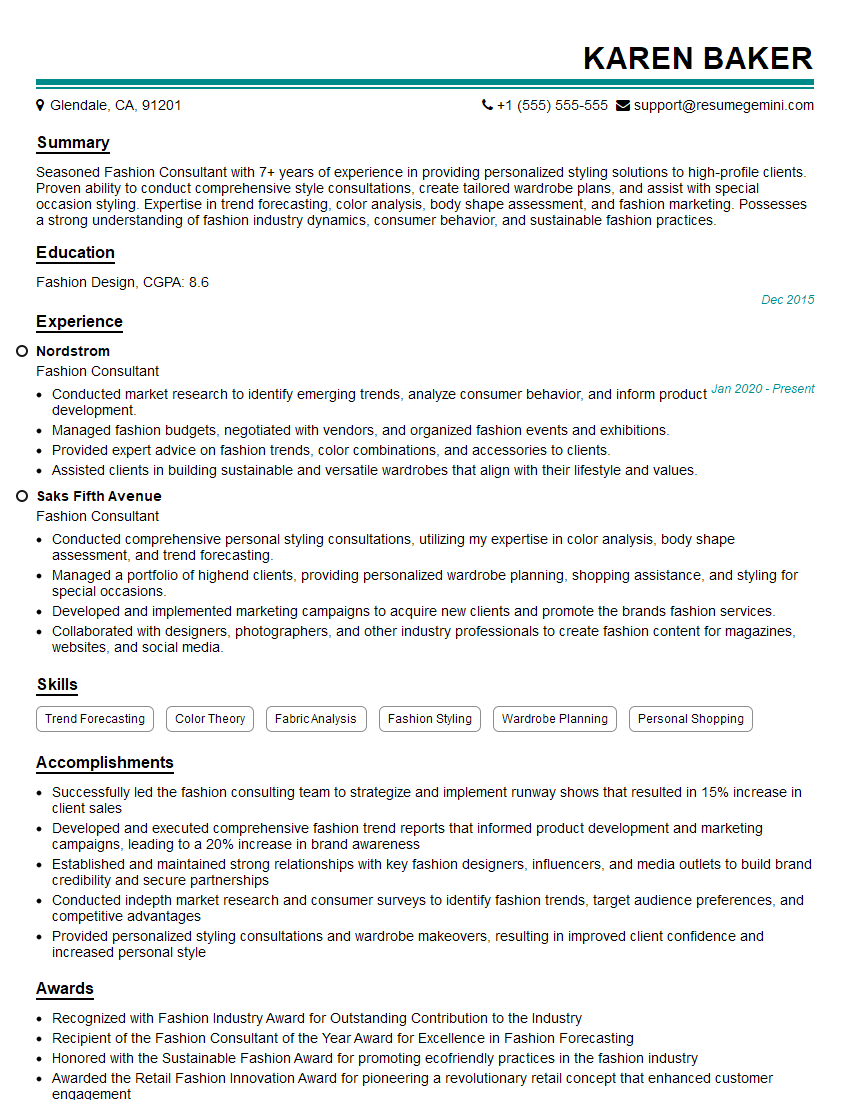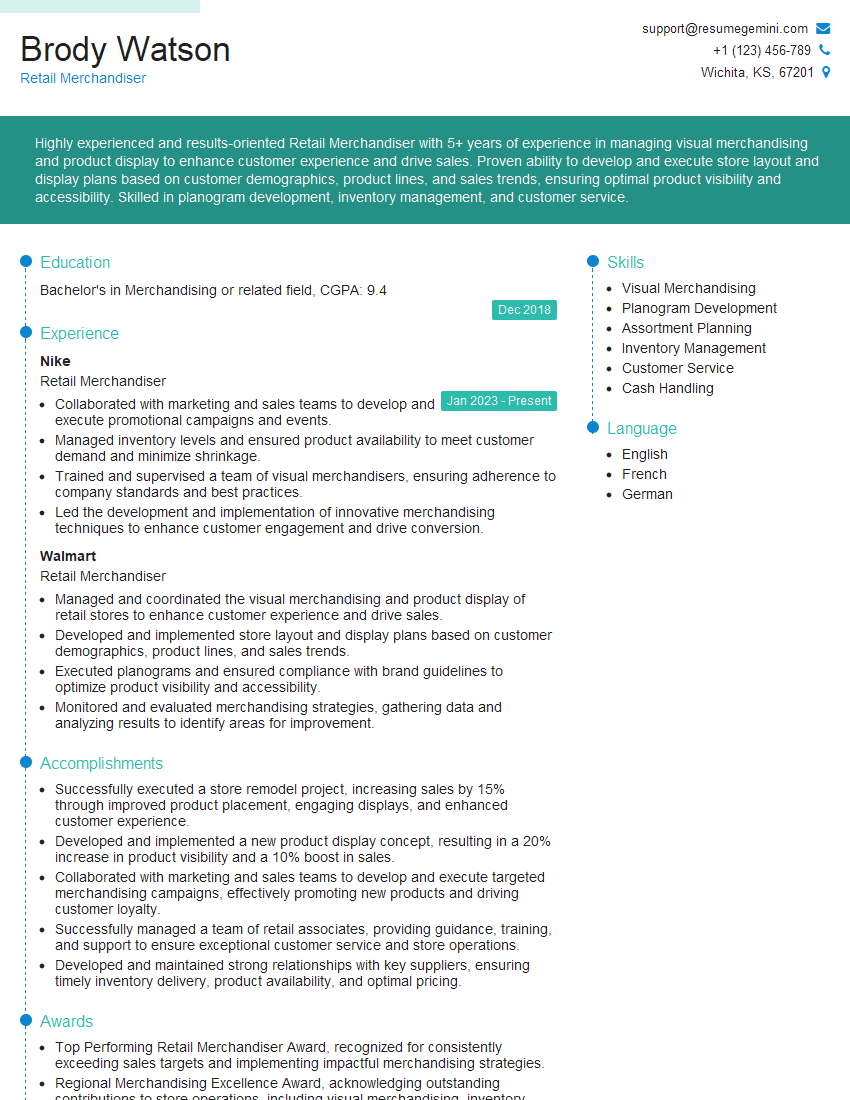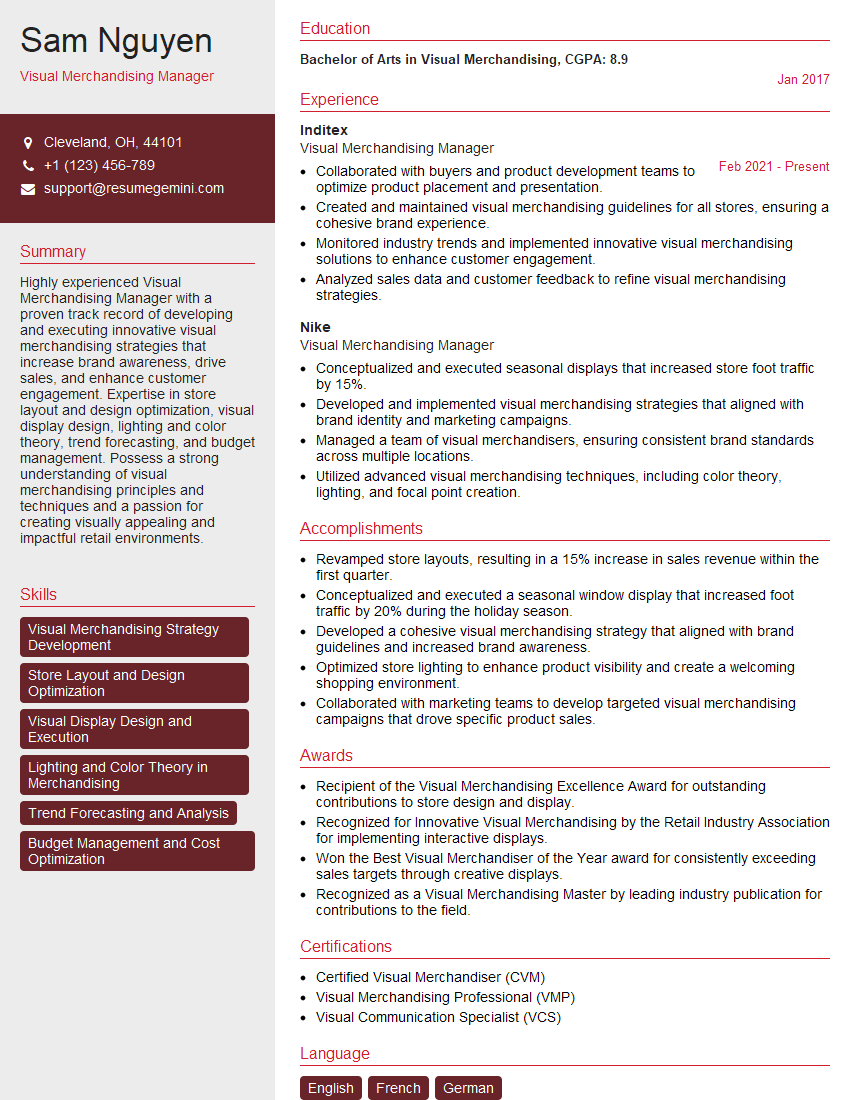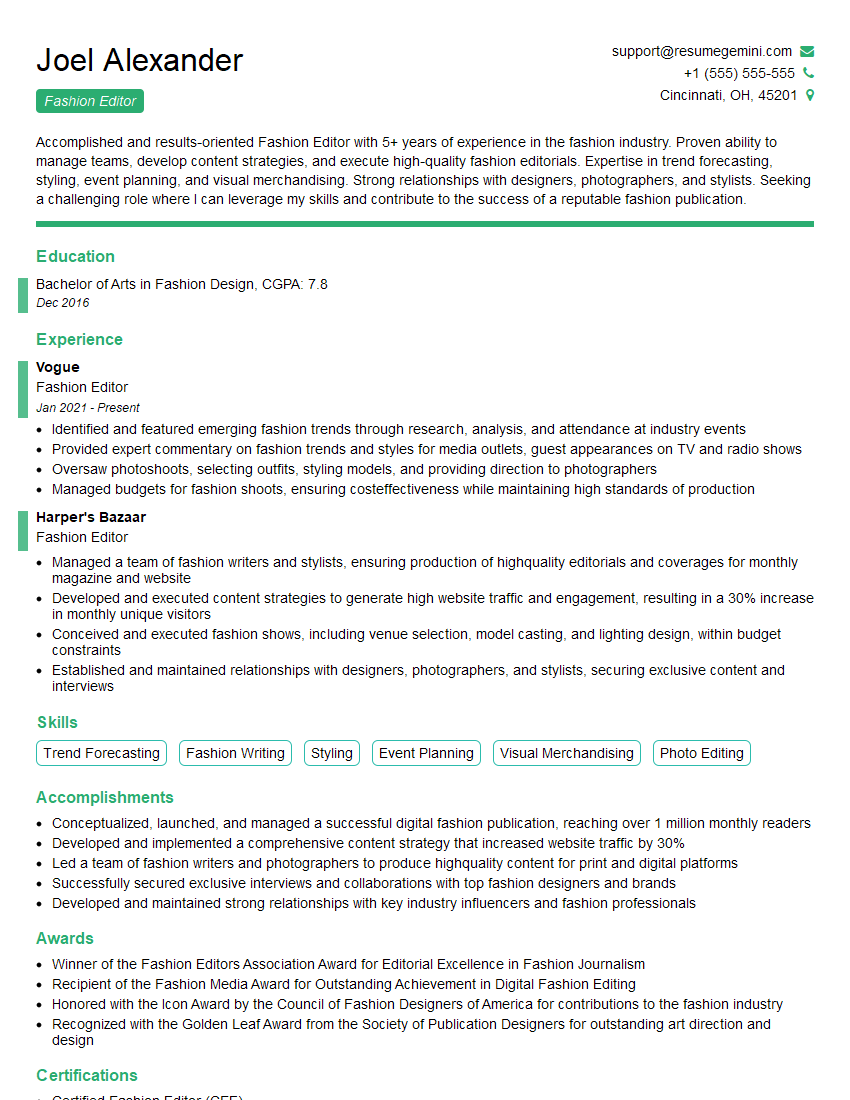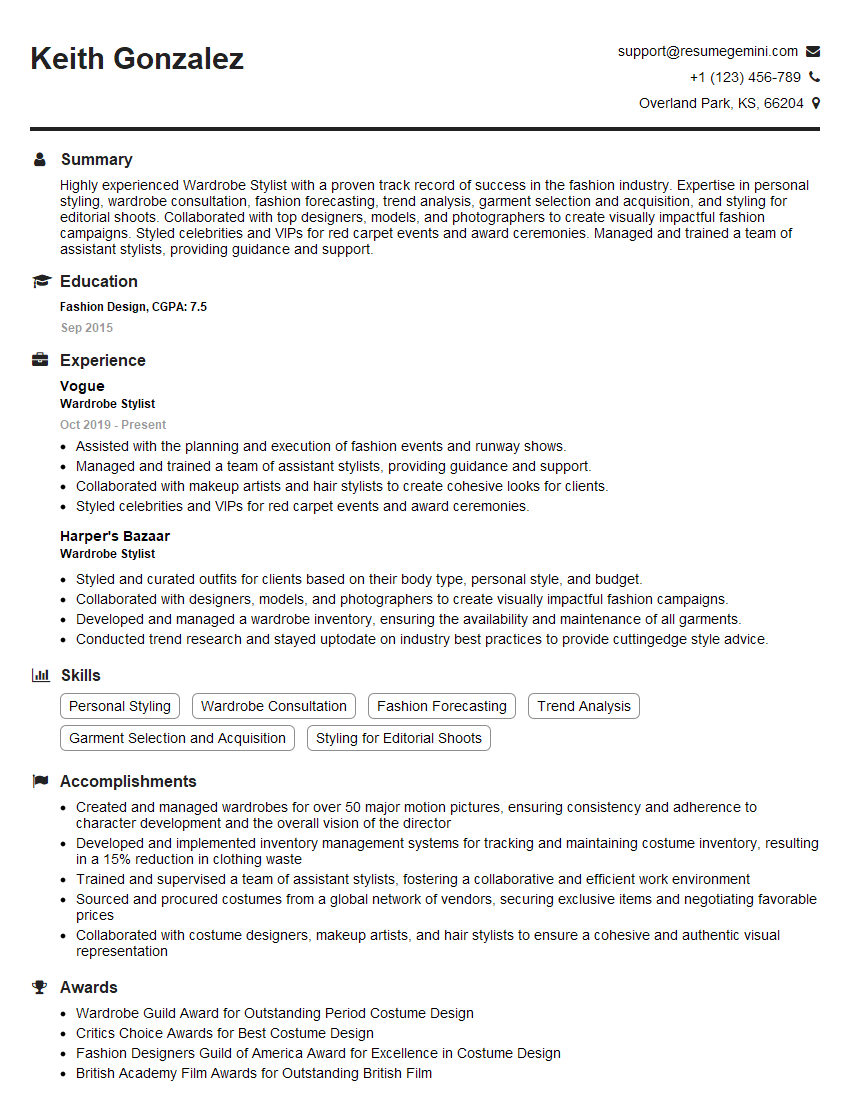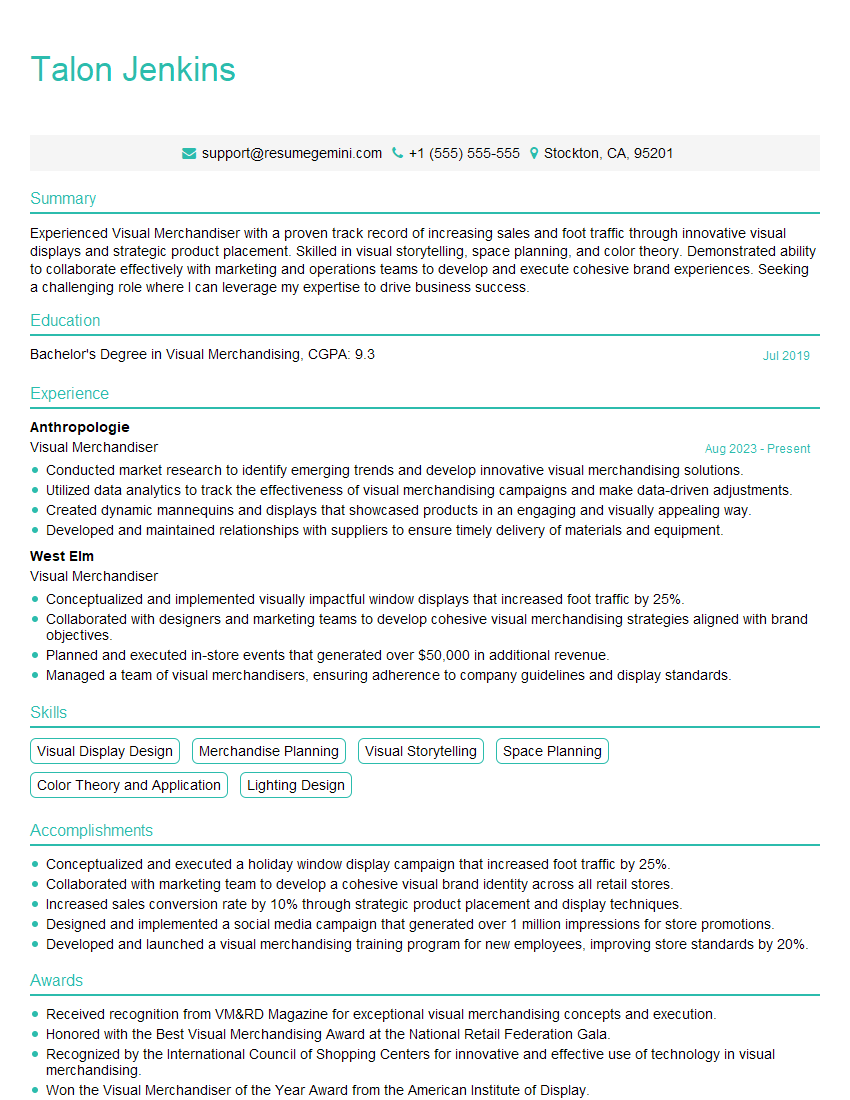Every successful interview starts with knowing what to expect. In this blog, we’ll take you through the top Fashion Styling and Merchandising interview questions, breaking them down with expert tips to help you deliver impactful answers. Step into your next interview fully prepared and ready to succeed.
Questions Asked in Fashion Styling and Merchandising Interview
Q 1. Describe your experience with trend forecasting and its impact on merchandising decisions.
Trend forecasting is the process of predicting upcoming fashion trends by analyzing various data points, including social media, runway shows, street style, and sales data. It’s crucial for making informed merchandising decisions because it allows businesses to anticipate consumer demand and allocate resources effectively.
In my experience, I’ve used trend forecasting to influence purchasing decisions. For example, by observing a growing interest in sustainable and ethically sourced materials on social media and in fashion blogs, I predicted a rise in demand for eco-friendly apparel. This led to my team prioritizing the sourcing of organic cotton and recycled fabrics for our next collection. Consequently, we experienced a significant increase in sales and positive brand perception.
My approach involves a combination of qualitative and quantitative analysis. I utilize tools like WGSN and Style.com to access professional trend reports, but I also actively engage in street style observation and social listening to gain a more nuanced understanding of emerging trends beyond the official reports. This holistic approach allows for a more accurate prediction and avoids solely relying on commercially-driven forecasts.
Q 2. Explain your understanding of the retail life cycle and its relevance to merchandising strategies.
The retail life cycle describes the stages a product goes through from its introduction to the market to its eventual decline. Understanding this cycle is fundamental to effective merchandising.
- Introduction: The product is launched, marketing efforts are focused on building awareness and generating initial sales.
- Growth: Sales increase rapidly as the product gains popularity. This is when merchandising strategies focus on maximizing market share and expanding distribution.
- Maturity: Sales growth slows down as the market becomes saturated. Merchandising strategies here may involve promotional pricing, product innovation, or targeting new market segments.
- Decline: Sales decrease significantly, and the product may be discontinued. Merchandising might focus on reducing inventory or clearing out remaining stock.
For instance, when managing a fast-fashion brand, we utilize the retail life cycle to quickly capitalize on trending items during their growth phase, while strategically reducing prices and marketing efforts for items entering the decline phase to make room for newer trends. This ensures efficient inventory management and minimizes losses.
Q 3. How do you balance creative vision with commercial viability in fashion styling?
Balancing creative vision with commercial viability is a constant juggling act in fashion styling. It involves understanding the target market, brand identity, and business goals while still expressing artistic flair.
I approach this by first thoroughly researching the brand’s aesthetic, target audience, and the overall market landscape. Then, I develop mood boards and style guides to visualize my creative vision, ensuring that it aligns with the brand’s identity and commercial goals. For example, if the brand is targeting a young, budget-conscious customer, I will incorporate more affordable clothing options and trendier items that align with their style preferences, even if a more avant-garde concept is personally appealing. I use data analytics to understand what’s selling and what’s not to ensure my vision resonates with the target customer without sacrificing creative integrity. Ultimately, striking this balance leads to collections that are both aesthetically pleasing and financially successful.
Q 4. What software or tools are you proficient in for fashion styling or merchandising?
Proficiency in various software and tools is essential for efficient fashion styling and merchandising. I’m adept at using:
- Adobe Creative Suite (Photoshop, Illustrator, InDesign): For creating mood boards, flat lays, lookbooks, and marketing materials.
- Microsoft Office Suite (Excel, PowerPoint): For data analysis, sales reporting, and presentations.
- PLM (Product Lifecycle Management) software: For managing product development and tracking inventory.
- Various visual merchandising and style guide software: These applications often provide collaborative tools and enhance speed and quality of style guides.
For example, I use Photoshop to retouch images for online catalogs and create visually appealing presentations for new product launches. Excel is vital for analyzing sales data to inform purchasing decisions for future collections.
Q 5. Describe a time you had to manage conflicting priorities in a fast-paced fashion environment.
During a major fashion show, we faced a last-minute change in the model lineup due to an unexpected illness. This meant re-styling several outfits within hours, adjusting the entire show’s flow, and communicating effectively with the team, designers, and show producers.
My approach was to prioritize clear communication and efficient delegation. I immediately assessed the situation, divided tasks among the team based on expertise, and utilized existing resources creatively. Instead of panicking, we collaborated effectively. The team’s adaptability and swift action allowed us to complete the show successfully, with minimal disruption to the overall presentation. This experience highlighted the importance of effective team work, adaptability, and problem-solving skills in a high-pressure environment.
Q 6. How do you stay updated on current fashion trends and market insights?
Staying updated on fashion trends requires a multi-faceted approach. I utilize several key methods:
- Industry Publications and Trend Forecasting Agencies: WGSN, Stylesight, and other fashion trend forecasting agencies provide valuable insights into upcoming seasons.
- Social Media Monitoring: Platforms like Instagram, TikTok, and Pinterest offer real-time information on what’s trending among consumers.
- Runway Shows and Fashion Weeks: Attending or reviewing coverage from fashion shows provides insights into designer collections and emerging styles.
- Retail Analysis: Regularly reviewing the performance of top performing retailers like Zara, H&M and others can expose emerging and lasting trends.
- Networking: Attending industry events and connecting with other professionals allows for the exchange of information and perspectives.
This combination of formal and informal research methods ensures a holistic and comprehensive understanding of current and emerging trends. It’s not just about identifying trends but understanding the ‘why’ behind them – the cultural shifts, technological advancements, and consumer behaviors that drive them.
Q 7. What is your approach to developing a cohesive and marketable product line?
Developing a cohesive and marketable product line involves a strategic process. It starts with defining the target customer and understanding their needs and preferences.
Step 1: Market Research and Trend Analysis: Thoroughly researching market trends, analyzing competitor offerings, and identifying unmet consumer needs are crucial first steps. This informs the overall direction of the collection.
Step 2: Concept Development: Creating a strong concept that informs the entire line is essential. This includes defining the overall theme, color palette, fabric selection, and style direction.
Step 3: Product Design and Development: Designing products that align with the concept and meet the target audience’s needs is crucial. This includes technical design specifications and sourcing decisions.
Step 4: Production and Quality Control: Ensuring the quality of the final products through careful selection of manufacturers and quality control measures.
Step 5: Marketing and Sales Strategy: Creating a marketing and sales strategy to effectively communicate the product line’s value proposition to the target customer. This will utilize various approaches including social media engagement, targeted ads and influencer marketing.
For example, in creating a sustainable activewear line, we first researched the growing interest in eco-friendly activewear, understanding the consumer’s needs for performance and ethical sourcing. We then developed a concept incorporating recycled materials, functional designs, and a muted color palette that appealed to a sophisticated customer. Through these steps we create a cohesive and marketable product line that resonates with the intended customer.
Q 8. Explain your experience in creating visually appealing displays for retail spaces.
Creating visually appealing retail displays is about storytelling. It’s not just about placing clothes on mannequins; it’s about crafting a narrative that resonates with the target customer and encourages them to buy. My approach involves a deep understanding of the brand’s identity, the current season’s trends, and the specific demographics of the store’s location.
For example, for a high-end boutique, I might curate a display focused on minimalist elegance, using a neutral color palette and showcasing key pieces with strategic lighting and carefully chosen props. In contrast, for a younger, trendier brand, I’d incorporate bolder colors, playful textures, and maybe even interactive elements to create a more energetic and engaging atmosphere. I consider the overall flow of the store, creating visual focal points and ensuring a cohesive look throughout. I utilize different display techniques like ladder displays for showcasing knitwear, ghost mannequins for highlighting intricate detailing, and color-blocking to create visual impact. I always ensure that the display is easy to navigate and shoppable, with clear pricing and size information readily available.
I meticulously plan each display, sketching layouts and creating mood boards before execution. This ensures a cohesive and successful final product. I’m also adept at utilizing digital tools to visualize displays before implementation, allowing for adjustments and refinements to optimize the final result.
Q 9. How do you handle feedback from clients or stakeholders regarding styling choices or merchandising strategies?
Feedback is crucial in merchandising and styling. I view it as an opportunity for growth and refinement. My approach involves active listening and seeking to understand the perspective of the client or stakeholder. I start by clarifying their concerns and understanding the rationale behind their feedback. I then evaluate the feedback objectively, considering whether it aligns with the overall brand strategy and target market.
Sometimes, feedback may highlight areas where I can improve my execution. For instance, if a client feels a display lacks energy, I might re-evaluate the color palette or incorporate more dynamic props. Other times, feedback might involve disagreements on stylistic choices. In such cases, I present data – like sales figures for similar items or consumer preferences from market research – to support my choices while remaining open to collaborative solutions. A healthy discussion, respecting everyone’s input, leads to the best outcomes. I document all feedback, using it to inform future projects and refine my processes.
Q 10. How do you analyze sales data to inform merchandising decisions?
Analyzing sales data is fundamental to effective merchandising. It provides insights into what’s working and what’s not, allowing for data-driven decision-making. I utilize various analytical tools and techniques to interpret this data effectively. I start by segmenting sales data by category, item, color, size, and sales period. This allows me to identify top performers, slow movers, and potential trends.
For example, if I notice consistently high sales for a particular style of dress in a specific color, I might prioritize that color and style in future purchases. Conversely, if certain items consistently underperform, I’ll investigate the reasons. This could involve reviewing pricing strategies, display placement, or even assessing if the item aligns with current market trends. I use this data to optimize inventory levels, plan promotions, and adjust marketing strategies. Visualizing this data through graphs and charts makes trends readily apparent. A key metric I often analyze is sell-through rate (the percentage of inventory sold within a specific period), which gives a clear picture of stock efficiency.
Q 11. Describe your experience working with diverse teams in fashion-related projects.
Collaboration is key in the fashion industry. Throughout my career, I’ve consistently worked in diverse teams, including designers, buyers, visual merchandisers, marketing professionals, and store staff. Effective teamwork requires clear communication, mutual respect, and a shared vision.
In one project, I collaborated with a design team to develop a capsule collection for a new line. This required understanding their design process, offering feedback on garment construction and overall styling, and ensuring that the final products were merchandised effectively. Another example involved working with marketing to align in-store displays with their online campaigns to build a holistic brand experience for the customer. I also actively participate in brainstorming sessions and team meetings, fostering a collaborative and inclusive environment where everyone feels comfortable contributing their unique perspectives and expertise. This collaborative approach strengthens projects and cultivates a positive working environment.
Q 12. What is your experience with budgeting and financial planning in merchandising?
Budgeting and financial planning are critical for successful merchandising. My experience involves developing and managing budgets for various projects, from individual window displays to complete store renovations. I begin by meticulously researching and gathering information about the costs of all materials, labor, and any additional expenses involved.
I then create a detailed budget outlining these costs, ensuring there’s a clear allocation of funds to each aspect of the project. This includes factoring in contingency planning for unexpected expenses. I regularly monitor expenses against the budget, ensuring we stay within allocated funds. I use spreadsheet software to track spending, allowing for real-time analysis of the project’s financial health. Moreover, I present regular budget updates to stakeholders, highlighting any potential risks or deviations from the original plan. Proactive financial management is paramount to ensuring projects stay within budget and deliver the desired return on investment.
Q 13. How do you identify key performance indicators (KPIs) for success in merchandising?
Key Performance Indicators (KPIs) are essential for measuring the success of merchandising strategies. These are specific, measurable, achievable, relevant, and time-bound (SMART) metrics that track progress and provide insights into areas for improvement.
Some key KPIs I regularly track include:
- Sales per square foot: Measures the revenue generated per square foot of retail space, indicating the efficiency of space utilization.
- Sell-through rate: Tracks the percentage of inventory sold within a given period, showing inventory management efficiency.
- Average transaction value (ATV): Measures the average amount spent per customer transaction, indicating the effectiveness of upselling and cross-selling techniques.
- Conversion rate: Tracks the percentage of customers who make a purchase after entering the store, reflecting the effectiveness of displays and overall store atmosphere.
- Gross margin return on investment (GMROI): Measures the profitability of inventory, showing how effectively inventory investments translate into profits.
By monitoring these KPIs, I can identify areas of strength and weakness, allowing me to refine strategies and optimize merchandising efforts for greater profitability.
Q 14. How do you approach the process of sourcing and selecting appropriate garments for a specific styling project?
Sourcing and selecting garments for a specific styling project requires a thorough understanding of the project’s objectives, target audience, and brand identity. My process is multifaceted and starts with thorough research.
I begin by defining the project’s overall aesthetic and mood. I then identify key trends and colors relevant to the season and target market. This is informed by analyzing trend reports, attending fashion shows, and researching social media platforms. Once I have a clear vision, I explore various sourcing options, considering factors like price point, quality, ethical sourcing, and lead times. I evaluate samples from different vendors, ensuring the garments align with the project’s quality standards and aesthetic vision. Selection involves considering factors like fabric, silhouette, color, and texture, aiming for a cohesive and visually appealing collection. Ultimately, the goal is to source garments that not only meet the aesthetic requirements but also align with the project’s budget and timeline.
Q 15. Describe your familiarity with different fabric types and their appropriate use in garment construction.
Understanding fabric properties is fundamental to successful garment construction and styling. Different fabrics possess unique characteristics impacting drape, texture, durability, and suitability for various garments.
- Natural Fibers: Cotton is breathable and absorbent, ideal for summer wear; linen is durable but wrinkles easily, suitable for structured garments; silk is luxurious and drapes beautifully, perfect for evening wear; wool provides warmth and insulation, suitable for outerwear.
- Synthetic Fibers: Polyester is wrinkle-resistant and durable, often used in sportswear; nylon is strong and stretchy, commonly found in activewear; rayon drapes well and is often used in flowing dresses; acrylic is a wool substitute, often used in knitwear.
- Blends: Many fabrics are blends combining natural and synthetic fibers to leverage the best properties of each. For example, a cotton-polyester blend offers the breathability of cotton with the wrinkle resistance of polyester.
For instance, when designing a summer dress, I’d opt for lightweight cotton or linen for breathability and comfort. For a winter coat, I’d choose a wool blend for warmth and durability. Knowing the limitations and strengths of each fabric informs every design decision, from silhouette to construction techniques.
Career Expert Tips:
- Ace those interviews! Prepare effectively by reviewing the Top 50 Most Common Interview Questions on ResumeGemini.
- Navigate your job search with confidence! Explore a wide range of Career Tips on ResumeGemini. Learn about common challenges and recommendations to overcome them.
- Craft the perfect resume! Master the Art of Resume Writing with ResumeGemini’s guide. Showcase your unique qualifications and achievements effectively.
- Don’t miss out on holiday savings! Build your dream resume with ResumeGemini’s ATS optimized templates.
Q 16. How do you collaborate effectively with designers and other creative professionals?
Collaboration is crucial in fashion. I foster effective teamwork by prioritizing clear communication, active listening, and mutual respect. I believe in a collaborative process where everyone’s ideas are valued.
- Open Communication: I hold regular meetings, share design concepts and mood boards early, and solicit feedback throughout the design process. This ensures everyone is on the same page and potential issues are addressed proactively.
- Shared Vision: Before commencing a project, I work with designers to establish a clear shared vision, understanding the brand identity, target audience, and overall aesthetic. This helps maintain consistency and focus.
- Constructive Feedback: I provide constructive criticism, focusing on solutions rather than simply pointing out flaws. I also welcome feedback from others, understanding that different perspectives enrich the creative process.
For example, in a recent project, I worked closely with a designer to develop a sustainable clothing line. By openly discussing material sourcing, production techniques, and marketing strategies, we created a collection that aligned perfectly with the brand’s values and resonated with the target audience.
Q 17. What are your strategies for managing inventory and preventing stockouts or overstocking?
Inventory management is critical for profitability and customer satisfaction. My strategies focus on accurate forecasting, real-time tracking, and data-driven decision-making.
- Demand Forecasting: I leverage historical sales data, market trends, and seasonal variations to predict demand for each item. This involves analyzing past performance, considering upcoming events or promotions, and assessing competitor activity.
- Inventory Tracking: I utilize inventory management software to track stock levels in real-time, identifying slow-moving items and potential stockouts. This allows for proactive reordering or promotional strategies to clear out excess inventory.
- Just-in-Time Inventory: For certain high-demand items, I employ a just-in-time inventory system, ordering only what is needed to minimize storage costs and reduce the risk of obsolescence.
- Data Analysis: Regular analysis of sales data, website traffic, and customer feedback helps refine forecasting models and optimize inventory levels, minimizing both overstocking and stockouts.
For instance, during a particularly successful launch of a new handbag, we used real-time sales data to quickly reorder and avoid disappointing customers. Conversely, for slow-moving items, we implemented markdowns to stimulate sales and free up warehouse space.
Q 18. Explain your understanding of different pricing strategies in the fashion industry.
Pricing strategies are crucial for profitability and brand positioning. Different approaches cater to different market segments and brand objectives.
- Cost-Plus Pricing: This method involves calculating the cost of production and adding a markup to determine the selling price. It’s straightforward but may not reflect market demand.
- Value-Based Pricing: This strategy focuses on the perceived value of the product to the customer. Luxury brands often use this, charging premium prices based on quality, exclusivity, and brand image.
- Competitive Pricing: This involves setting prices based on competitor pricing. It’s important to consider the value proposition and differentiation from competitors.
- Penetration Pricing: This involves setting a low initial price to quickly gain market share. This is often used for new product launches.
- Price Skimming: This involves initially setting a high price for a new product and gradually lowering it over time. This is suitable for innovative or highly desirable products.
For a new clothing line targeting young adults, I might use penetration pricing to attract a large customer base. However, for a luxury brand, I’d employ value-based pricing, highlighting the quality of materials and craftsmanship to justify the higher price point.
Q 19. How do you evaluate the success of a fashion styling project or a merchandising campaign?
Evaluating the success of a fashion styling project or merchandising campaign requires a multifaceted approach using quantitative and qualitative data.
- Sales Data: Analyzing sales figures for styled items helps determine the direct impact on revenue. Tracking key metrics like conversion rates, average order value, and sales per square foot (for brick-and-mortar stores) is crucial.
- Customer Feedback: Gathering feedback through surveys, reviews, and social media monitoring provides insights into customer satisfaction and perception of the styling and merchandising efforts.
- Website Analytics: Analyzing website traffic, bounce rates, and time spent on product pages reveals the effectiveness of online merchandising and visual displays.
- Social Media Engagement: Monitoring social media mentions, shares, and likes helps assess brand awareness and engagement with the styling concepts.
- Return on Investment (ROI): Calculating the return on investment for each project allows for a clear understanding of the financial success and guides future decisions.
For example, a successful campaign might show a significant increase in sales for featured items, positive customer reviews, and high engagement on social media, indicating a strong ROI and justifying the investment in the styling and merchandising strategy.
Q 20. How do you adapt your styling approach to different target audiences and brand identities?
Adaptability is key in fashion styling. Understanding the target audience and brand identity informs every styling decision, from color palettes and silhouettes to fabric choices and accessories.
- Target Audience Research: I conduct thorough research to understand the demographics, lifestyle, and preferences of the target audience. This includes analyzing market trends, studying competitor strategies, and gathering insights from focus groups or surveys.
- Brand Identity Alignment: I ensure the styling aligns with the brand’s values, personality, and overall aesthetic. This means understanding the brand’s history, mission, and target market to create a cohesive look and feel.
- Style Guides and Mood Boards: I develop style guides and mood boards to visually communicate the desired aesthetic and ensure consistency across all styling efforts.
- Flexibility and Innovation: I’m open to experimenting with different styles and approaches, while always keeping the target audience and brand identity in mind. I recognize that trends change and adapt my strategies accordingly.
For instance, styling a collection for a young, trendy brand would involve incorporating bold colors, unique prints, and contemporary silhouettes. In contrast, styling for a classic, sophisticated brand would focus on timeless pieces, neutral color palettes, and elegant designs.
Q 21. How familiar are you with various retail channels (e.g., brick-and-mortar, online)?
I’m familiar with various retail channels and their unique characteristics, understanding that each requires a different approach to merchandising and visual presentation.
- Brick-and-Mortar Stores: I understand the importance of visual merchandising, store layout, and in-store displays to create an engaging shopping experience. This includes strategic product placement, effective signage, and creating visually appealing displays.
- Online Retail: I’m proficient in e-commerce platforms, understanding the need for high-quality product photography, detailed descriptions, and intuitive website navigation. I also understand the importance of SEO and digital marketing strategies to reach online customers.
- Omnichannel Retail: I recognize the importance of integrating online and offline channels to provide a seamless and consistent customer experience. This might involve offering click-and-collect options, using online data to inform in-store displays, or creating consistent branding across all channels.
- Social Commerce: I understand the growing importance of social media in driving sales. This includes utilizing platforms like Instagram and Pinterest for product promotion, using influencer marketing, and running targeted social media advertising campaigns.
For example, I’d approach merchandising for an online store by focusing on high-quality product images, detailed product descriptions, and incorporating customer reviews to build trust and encourage purchases. For a brick-and-mortar store, I would prioritize in-store displays, strategic product placement, and staff training to enhance customer service and the overall shopping experience.
Q 22. Describe your experience with visual merchandising techniques for online platforms.
Visual merchandising for online platforms hinges on creating an engaging and intuitive customer experience that translates the brand’s aesthetic and story digitally. It’s about showcasing products in a way that inspires purchases, just as a well-designed physical store would.
My experience involves leveraging high-quality product photography and videography, employing lifestyle imagery to show products in use, and strategically using interactive elements like zoom capabilities and 360° views. For example, I’ve worked on projects where we used 3D modeling to showcase intricate details of jewelry or clothing textures that might be lost in a standard 2D image.
Another key aspect is effective product categorization and navigation. Clear menus, intuitive search functionalities, and well-organized collections are crucial. Think of it like curating a digital storefront – you want customers to find what they’re looking for easily, and ideally, discover related items they might also love. Finally, I’ve utilized A/B testing to optimize various visual elements such as image placement, color schemes, and call-to-action buttons to maximize conversion rates.
Q 23. How do you resolve conflicts arising from differing opinions within a styling or merchandising team?
Disagreements are inevitable in creative fields. My approach to resolving conflicts within a styling or merchandising team prioritizes open communication, constructive feedback, and a collaborative problem-solving mindset. I start by encouraging every team member to articulate their perspective clearly and respectfully. We then brainstorm solutions together, considering the pros and cons of each approach.
Often, the best outcome emerges from finding common ground – a synthesis of different viewpoints. For instance, in a recent disagreement about the color palette for an autumn collection, one team member advocated for earthy tones while another preferred bolder jewel tones. We ultimately created a collection that beautifully blended both preferences, resulting in a richer and more diverse aesthetic. In cases where compromises are impossible, I facilitate a decision-making process that prioritizes the overarching brand strategy and target market needs.
Q 24. What is your process for identifying and responding to emerging fashion trends?
Identifying and responding to emerging fashion trends requires a multi-pronged approach. I actively monitor various resources, including trade publications (like Women’s Wear Daily and Vogue), fashion blogs, social media platforms (especially Instagram and TikTok), and trend forecasting agencies. This provides a holistic view, combining professional insights with grassroots trends.
I also participate in industry events and trade shows, connecting with designers, buyers, and other professionals to get a pulse on the latest innovations and consumer preferences. Once I’ve identified promising trends, I analyze their potential for market penetration and alignment with our brand identity. For instance, if a certain sustainable fabric is gaining traction, I’d evaluate if incorporating it into our collections would resonate with our target customer while also reflecting our brand’s commitment to ethical practices. Finally, I integrate the relevant trends into our product development roadmap, ensuring that our designs and merchandising strategies remain current and appealing.
Q 25. Explain your experience with vendor negotiations and managing relationships.
Vendor negotiations and relationship management are critical for success in the fashion industry. My approach focuses on building long-term partnerships based on trust and mutual benefit. I begin by clearly defining our needs and expectations, including quality standards, delivery timelines, and pricing requirements. I thoroughly research potential vendors, evaluating their production capabilities, sustainability practices, and past performance.
During negotiations, I employ a collaborative strategy, focusing on open communication and a win-win outcome. For instance, when negotiating with a new textile supplier, I demonstrated the value of our long-term partnership by guaranteeing a consistent order volume in exchange for favorable pricing and flexible payment terms. This approach strengthens relationships and ensures smooth operations. I regularly track vendor performance, addressing any challenges proactively and ensuring consistent quality and adherence to agreements. This holistic approach fosters strong, mutually beneficial partnerships.
Q 26. How do you ensure the consistency of brand identity across different styling projects or merchandising initiatives?
Maintaining consistent brand identity across styling projects and merchandising initiatives requires a well-defined brand style guide and thorough communication. The style guide acts as a central repository for all brand-related elements, including logo usage, color palettes, typography, imagery style, and overall tone of voice. This guide is crucial in ensuring consistency across all touchpoints, from product photography to marketing materials.
Regular training sessions for the styling and merchandising teams ensure everyone understands and adheres to the brand guidelines. For instance, when launching a new campaign, we hold workshops to clarify the brand messaging, aesthetic direction, and target audience. Moreover, we use consistent templates and visual assets across all platforms, from our website to social media. This careful attention to detail ensures a cohesive brand experience for our customers, regardless of where they interact with our products.
Q 27. Describe your experience in using data analytics to improve merchandising performance.
Data analytics plays a vital role in optimizing merchandising performance. I leverage various data sources, including sales data, website analytics, and customer feedback, to gain insights into product performance, customer behavior, and overall market trends. This data allows me to identify best-selling products, understand customer preferences, and predict future demand.
For example, by analyzing website analytics, we identified a high bounce rate on a specific product page. Through further investigation, we discovered that the product images were not effectively conveying its features and benefits. We improved the product photography and descriptions, leading to a significant increase in conversions. We also utilize sales forecasting models to optimize inventory levels and avoid stockouts or overstocking. This data-driven approach ensures that we are efficiently allocating resources and maximizing sales potential.
Q 28. How do you handle pressure and meet deadlines in a demanding fashion industry environment?
The fashion industry is fast-paced and demanding, requiring the ability to handle pressure and meet deadlines effectively. My strategies for managing this pressure involve meticulous planning, prioritization, and effective time management. I break down large projects into smaller, manageable tasks, setting realistic deadlines for each. I also leverage project management tools to track progress and identify potential bottlenecks.
Furthermore, I foster a collaborative environment within my team, encouraging open communication and mutual support. If deadlines are particularly tight, I might adjust task assignments to optimize workflow or even bring in additional resources as needed. For instance, during the peak of a major seasonal launch, I delegated specific tasks to freelancers specializing in areas such as image editing or social media management. This proactive approach allows me to meet demands without compromising quality or team morale.
Key Topics to Learn for Your Fashion Styling & Merchandising Interview
- Visual Merchandising & Display: Understanding principles of visual merchandising, including color theory, space planning, and creating compelling window displays. Practical application: Describe how you would create a visually appealing display for a new spring collection.
- Trend Forecasting & Analysis: Identifying emerging trends, analyzing market data, and predicting future fashion directions. Practical application: Explain your process for researching and interpreting upcoming fashion trends.
- Styling Techniques & Principles: Mastering the art of styling garments, accessories, and overall looks for various occasions and target audiences. Practical application: Discuss your approach to creating a cohesive and stylish look for a photoshoot.
- Fashion Buying & Merchandising: Understanding the process of sourcing products, managing inventory, and analyzing sales data to inform buying decisions. Practical application: Describe your strategy for selecting the right pieces for a specific retail store’s target demographic.
- Brand Identity & Communication: Building and maintaining a consistent brand image through styling, marketing, and visual communication. Practical application: Explain how you would represent a brand’s identity through a social media campaign.
- Market Research & Consumer Behavior: Understanding consumer preferences, market trends, and competitive analysis. Practical application: Discuss how you would research the needs and desires of a specific target market.
- Sustainability & Ethical Sourcing: Understanding and implementing sustainable and ethical practices in the fashion industry. Practical application: Explain your approach to sourcing sustainable materials or supporting ethical brands.
Next Steps
Mastering Fashion Styling and Merchandising opens doors to exciting career paths, offering opportunities for creative expression and significant professional growth. To maximize your job prospects, a strong, ATS-friendly resume is crucial. This is where ResumeGemini can help! ResumeGemini offers a streamlined approach to building a professional resume that highlights your skills and experience effectively. We provide examples of resumes tailored to Fashion Styling and Merchandising to help you create a compelling application that stands out from the competition. Invest in your future; create a resume that reflects your talent and ambition.
Explore more articles
Users Rating of Our Blogs
Share Your Experience
We value your feedback! Please rate our content and share your thoughts (optional).
What Readers Say About Our Blog
Hello,
We found issues with your domain’s email setup that may be sending your messages to spam or blocking them completely. InboxShield Mini shows you how to fix it in minutes — no tech skills required.
Scan your domain now for details: https://inboxshield-mini.com/
— Adam @ InboxShield Mini
Reply STOP to unsubscribe
Hi, are you owner of interviewgemini.com? What if I told you I could help you find extra time in your schedule, reconnect with leads you didn’t even realize you missed, and bring in more “I want to work with you” conversations, without increasing your ad spend or hiring a full-time employee?
All with a flexible, budget-friendly service that could easily pay for itself. Sounds good?
Would it be nice to jump on a quick 10-minute call so I can show you exactly how we make this work?
Best,
Hapei
Marketing Director
Hey, I know you’re the owner of interviewgemini.com. I’ll be quick.
Fundraising for your business is tough and time-consuming. We make it easier by guaranteeing two private investor meetings each month, for six months. No demos, no pitch events – just direct introductions to active investors matched to your startup.
If youR17;re raising, this could help you build real momentum. Want me to send more info?
Hi, I represent an SEO company that specialises in getting you AI citations and higher rankings on Google. I’d like to offer you a 100% free SEO audit for your website. Would you be interested?
Hi, I represent an SEO company that specialises in getting you AI citations and higher rankings on Google. I’d like to offer you a 100% free SEO audit for your website. Would you be interested?
good
